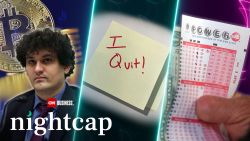Editor’s Note: A version of this story appeared in CNN Business’ Nightcap newsletter. To get it in your inbox, sign up for free, here.
I don’t know about y’all, but I could use some hopeful news today. So here’s what I’ve got: Inflation appears to be — really, this time — easing.
Here’s the deal: There are two main ways economists measure inflation in the US, and the Fed’s preferred metric, called the PCE, or Personal Consumption Expenditures price index (if you’re fancy about it,) is cooling off.
The PCE reading for October showed prices up 6% from a year ago. That’s down from 6.3% in September.
And if you take out the prices of food and energy, which tend to skew monthly readings because they’re so volatile, the index rose just 5% over the past 12 months.
(The other metric, the Consumer Price Index, tends to be the more commonly talked about one, but we’re not taking sides here. They’re both fine, and flawed, like most economic models. If you’re interested in the differences, you can read about them here).
What’s that all mean?
The PCE is essentially confirming what the CPI has shown: It’s a tale of two inflations.
1) Service inflation -— think health care, restaurants, travel, etc. — is ticking up.
2) Prices of goods are softening, particularly in areas like home furnishings and cars — two items that were in peak demand during the worst of the pandemic.
OK, so, what happens now?
The Fed should be pleased that its aggressive rate hikes in the past few months are having their desired effect, and they can ease up a bit. After four giant three-quarter-point hikes in a row, all signs point to Fed Chair Jay Powell announcing a half-point bump later this month.
BIG PICTURE
It’s taken most of the year, but the economy appears to have made it over the mountain of inflation and aggressive rate hikes, according to Peter Boockvar, chief investment officer at Bleakley Financial Group.
But the journey isn’t over.
“The next mountain needing to be conquered, and will be the 2023 focus I believe, is the economic consequences to such a sharp rise in interest rates, the higher cost of capital that both businesses and households have to deal with and the recession it creates,” he said.
NUMBER OF THE DAY: 200,000
Economists expect tomorrow’s closely watched jobs report to show hiring slowed in November, with just 200,000 positions added. That would mark the second month in a row of moderating growth.
But while 200,000 is nothing to sniff at, it’s still not soft enough for the Fed to pause its rate hikes. However, markets may cheer the fact that it’s low enough for the Fed to hike at a less aggressive pace than we’ve seen in recent months.
SIGNATURE DEBUT
Janet Yellen, the first female Treasury secretary in US history, said she’s made a concerted effort to avoid the chicken-scratch signatures that her predecessors imposed upon the mighty dollar.
“I knew this was something you could really screw up, and I wanted to get it right,” she told Stephen Colbert on CBS’ The Late Show. “I practiced, and I practiced.”
Soon, sheets of dollar bills rolling off the presses at the Fort Worth Bureau of Engraving and Printing will soon bear her signature, as is customary for the head of the Treasury.
Her predecessors set the bar pretty low.
Jack Lew’s loopty-loop scrawl “looked like how a child would draw smoke coming out of a chimney,” Colbert mused.
(Lew ultimately changed his signature before it landed on the nation’s bills. It was still pretty loopy.)
Tim Geithner’s was simply illegible, and he told Marketplace in 2012 that he had to tweak it to “something where people could read my name.”
Steven Mnuchin, similarly, cleaned up his signature and made it a non-cursive version for the bills bearing his name.
As my colleague Alicia Wallace reports, it’s been tradition for more than a century that both the US treasurer and the Treasury secretary sign currency to make them legal tender. Yellen’s bills were delayed while Biden appointed a new treasurer, Marilynn Malerba.
Bonus trivia: These will be the first US bills to bear the signatures of two women.

































